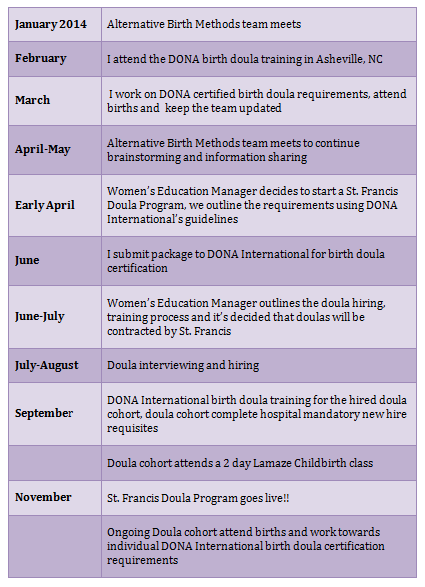 Editor’s Note: Sujata Gami has been on staff with the Women’s Education Department at St. Francis Hospital in Greenville, SC as a childbirth educator since 2007. Her experience with the Alternative Birth Methods team she describes below has inspired her to become a certified birth doula, doula mentor and volunteer as the SPAR (State/Regional/Area Representative) for DONA International. Her story illustrates how we can impact not only families with our work but our entire community – even hospitals and providers – and be personally changed by that experience.
Editor’s Note: Sujata Gami has been on staff with the Women’s Education Department at St. Francis Hospital in Greenville, SC as a childbirth educator since 2007. Her experience with the Alternative Birth Methods team she describes below has inspired her to become a certified birth doula, doula mentor and volunteer as the SPAR (State/Regional/Area Representative) for DONA International. Her story illustrates how we can impact not only families with our work but our entire community – even hospitals and providers – and be personally changed by that experience.
— Adrianne Gordon
In 2014, St. Francis Hospital in Greenville, SC formed an Alternative Birth Methods team, comprised of hospital administration, nurses, providers and educators. The objective of this interdisciplinary/collaborative team was to discuss and brainstorm growth strategies for hospital volume and promote communication among providers, nurses, the women’s education department and administrators using shared decision making and teamwork.
We discussed the major findings of the National Listening to Mother Survey III on attitudes, choice, control and decision making of childbearing families and its implications on perinatal care practice. Almost six in ten (59%) of the mothers in the survey agreed with the statement, ‘Giving birth is a process that should not be interfered with unless medically necessary.’ We discussed how the demographics of the population we served at St. Francis Women’s Hospital also had similar attitudes and wanted more choices and control in decision making.
In an open dialogue, our providers shared that their practices did offer choices and shared decision making to their patients; however, there were some areas where we as a team could focus our efforts to change perceptions related to meeting the non-medical, psychosocial needs of laboring women. We also discussed how our medical system is set up whereby the doctors and nurses are primarily responsible for the health and wellbeing of the mother and baby and that these priorities usually take precedence over the nonmedical, psychosocial needs of laboring women. The highly technical function of today’s clinical nurse and how it lessens her ability to give the type of continuous social support that can impact outcomes was also discussed. After exploring and talking about the role of a birth doula and the impact a trained, skilled labor support person can have to empower women, which can then lead to better birth outcomes and patient satisfaction, the team came to the consensus that a St. Francis Hospital Doula Program should be implemented.
Following the decision, my role was to understand the requirements of the DONA International birth doula certification process. I started the process of gathering information to chalk out the prerequisites of becoming a certified birth doula and, one step at a time, completed all of the requirements personally, including attending births as a doula in training. Throughout the process, I updated my manager in the Women’s Education department consistently about the doula’s Scope of Practice, details of documentation required, challenges I faced and feed-back from patients. My manager used the information to sketch out a plan to hire and train a cohort of doulas with the goal of having these newly hired birth doulas work as part of a team alongside our maternity-care providers and nurses at St. Francis Hospital.
Here is an outline of the milestones of conceptualizing, planning, implementing, hiring and training of the doula cohort:
By utilizing an integrated and collaborative interdisciplinary team approach, the Alternative Birth Methods initiative at St. Francis was successful in:
- Demonstrating effective communication between hospital administrators, providers, nurses and educators.
- Information sharing amongst the team regarding what worked and what could be done differently
- Conceptualizing, planning and implementing a hospital doula program set-up for success
- Planning and organizing an in-service training for labor and delivery nurses to ensure that they buy into the hospital doula program.
- Planning and organizing an in-service training for the newly hired doula cohort to ensure they were adequately trained to practice within the DONA International birth doula scope of practice.
- Working out scheduling details for best client doula match-ups so that laboring women’s needs are met and contracted doulas get adequate financially sustainable work.
Another significant outcome of the interdisciplinary team meetings was that it was decided to have a Lamaze Evidence Based Nursing training for our nurses. Like the DONA International birth doula training, this training is evidenced based and served to get everyone in the maternity care team on the same page to effectively meet the medical, emotional, physical and psychosocial needs of women in labor, which we expect will lead to both better birth outcomes and greater patient satisfaction.
— Sujata Gami, MS, LCCE, FACCE, CD(DONA)
Learn more about the St. Francis Doula Program.
Resources:
Ballen, LE, Fulcher, AJ. (2006). Nurses and doulas: Complementary roles to provide optimal maternity care. JOGNN; 35(2): 304-311
Declercq, ER, Sakala, C, Corry, MP, Applebaum, S, Herrlich, A. (2013). Listening to Mothers SM III: New Mothers Speak Out. New York: Childbirth Connection, June.
Klaus, M.H., Kennell, J.H., & Klaus, P.H. (2012). The doula book: How a trained labor companion can help you have a shorter, easier, and healthier birth. Boston, MA: Merloyd Lawrence Books. ISBN: 0738215066/ISBN-13:9780738215068.
Simkin, P. (2013). The birth partner: A complete guide to childbirth for dads, doulas, and all other labor companions (4th ed.). Boston, MA: Harvard Common Press.
Hodnett ED. (2002). Pain and women’s satisfaction with the experience of childbirth: a systematic review. Am J Obstet Gynecol; 186(5): S16072.
Hodnett, ED, Gates, S, Hofmeyr, GJ, Sakala, C, Weston, J.(2011). Continuous support for women during childbirth. Cochrane Database Syst Rev. Feb 16; (2):CD003766.
Gilliland ,AL. (2002). Beyond holding hands: The modern role of the professional doula. JOGNN; 31(6): 762–769.
Peddicord, K. (2012). Quality Patient Care in Labor and Delivery: A Call to Action. JOGNN; 41(1): 151–153, January/February.



I live in Los Angeles and would like to find out about training in my area to become a doula
Hi Debra –
There are many opportunities to train to become a doula, close by in your area. You can find a DONA workshop on our website. The incoming DONA President lives in LA and offers doula trainings, her name is Ana Paula Markel. There may be other trainers as well. You can also connect with the CA (Southern) state rep for more info: Mychal Balazs, 310-210-6670, doulamychal@gmail.com. Best wishes, Sharon Muza, Blog Manager.
I was wondering if the team of doulas is every hiring new doulas? I apologize if this isn’t the best place to ask, just wish I could work in a setting like this. And I didn’t know if the doulas work in shifts like the nurses do? Thank you